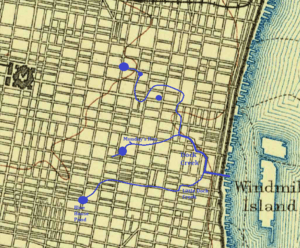Dock Creek facts for kids
Dock Creek was a small stream that once flowed through what is now the eastern part of Center City, Philadelphia. It was like a smaller river that fed into the much larger Delaware River. By the year 1820, the entire creek had been covered up and turned into an underground sewer. Today, if you walk along Dock Street in Philadelphia, you are walking over where the lower part of this old stream used to be.
Where Dock Creek Flowed
The native Lenape people, who lived in the area long before European settlers, called this stream Cooconocon. When William Penn first planned the city of Philadelphia, Dock Creek was right in the middle of his new settlement.
The area where the creek met the Delaware River was very marshy, like a swamp. Early Philadelphians even called it "The Swamp." The creek started near where Eleventh Street is today, between Arch and Race Streets.
From its start, the creek flowed through a pond near present-day Fifth and Market Streets. After that, it moved south and then east. Around Fourth and Chestnut Streets, another small stream called Munday's Run joined it. Dock Creek then continued southeast, meeting another small stream called Little Dock Creek, before finally flowing through the swamp and into the Delaware River.
Dock Creek in Colonial Times
William Penn believed the mouth of Dock Creek would be a great place for ships to dock, which is how the creek got its name. He wanted it to be a harbor forever, but people later changed his plan.
- By 1704, the first bridge in the colony of Pennsylvania was built over the creek near its mouth. This was a drawbridge, meaning it could be raised to let boats pass.
- More bridges were built later: at Second Street in 1713, Third Street in 1740, and Walnut Street in 1767.
As more people moved to Philadelphia, the creek became very dirty. By 1763, people complained that it was full of "dead dogs, and other trash." This made the air smell bad and was unhealthy for everyone living nearby.
Because of the smell and dirt, settlers started covering the creek. By 1769, the part of the creek above Second Street was covered. By 1784, the entire creek, all the way to the Delaware River, was buried underground.
Becoming an Underground Sewer
After being covered, Dock Creek became an underground sewer for the neighborhood. By the 1840s, this underground sewer wasn't big enough. It often overflowed, sending dirty water onto the streets above.
To fix this, investigators suggested that the Philadelphia City Council build a larger underground pipe, called a culvert, to carry the stream. They did this, and the old creek became a proper sewer system.
For many years, the Dock Street Market was a very important place in the city. It was the main center for selling fresh produce until it closed in 1959. Later, in the 1960s, during a time of big changes in the city called urban renewal, new sewer lines were built in the area. Archaeologists also explored the old site of the city's main waterfront.
In 2008, an art project during Philadelphia's FringeArts Festival explored the path of the old Dock Creek. This project focused on the area between Third and Fifth Streets, which is now part of Independence National Historical Park.


